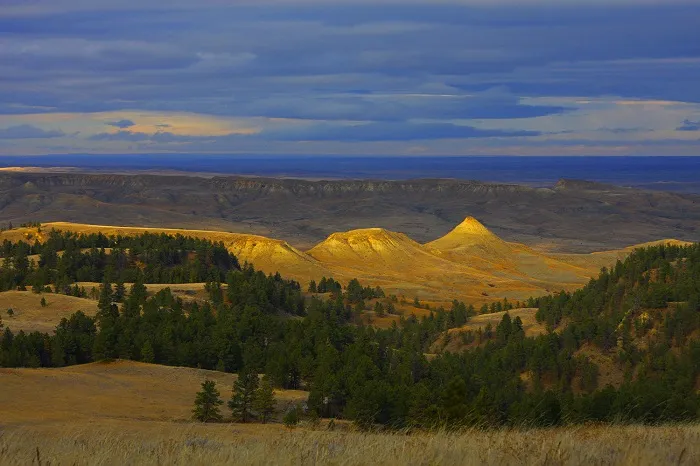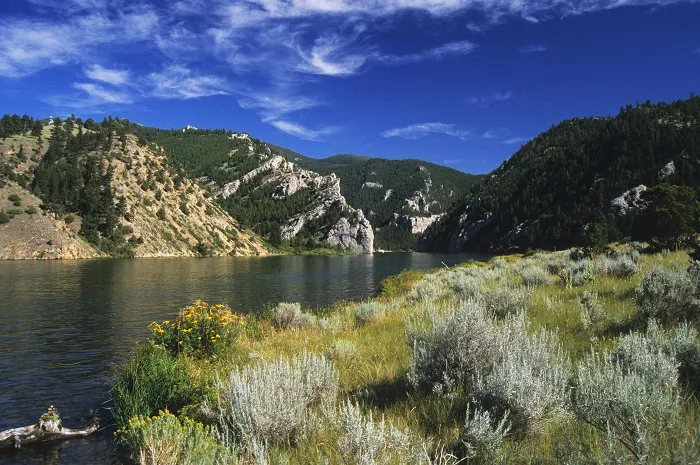The Missouri River, the lifeblood of North America, is not only the longest river in the United States but also a majestic natural symbol, playing a crucial role in the diverse and rich ecosystem of Montana. A journey to explore the Missouri River ecosystem will take you through breathtaking landscapes, from vast prairies to magnificent canyons, while offering opportunities for unique tourism activities and learning about the history and culture associated with this legendary river.
Missouri River – The Source of Life and Montana’s Beauty
The Missouri River flows through Montana like a ribbon of blue, winding through pristine and majestic lands. From its headwaters in the Rocky Mountains to its confluence with the Mississippi River, this river nurtures a lush ecosystem and sculpts unique natural landscapes, attracting visitors from all over the world. Exploring the Missouri River ecosystem is not just a journey to admire natural beauty but also an opportunity to deeply understand the connection between humans and the environment, between history and the present.
Must-Explore Areas Along the Missouri River
1. American Prairie Reserve – Where Wilderness Thrives
Spanning both north and south of the Missouri River, the American Prairie Reserve is one of the best destinations to explore the Missouri River ecosystem. It preserves a vast natural mixed-grass prairie ecosystem, home to many native wildlife species such as deer, elk, pronghorn, burrowing owls, bison, and bighorn sheep. The Missouri River serves as a lifeline, providing water and habitat for the animals and plants in the reserve, creating a vibrant and wild natural tapestry.

At the American Prairie Reserve, visitors can enjoy many exciting activities such as hiking, biking, camping, and wildlife watching. In particular, kayaking or canoeing on the Missouri River offers unique perspectives of the riverside ecosystem, helping you better appreciate the harmony between the river and the vast prairie.
2. Gates of the Mountains Wilderness – A Magnificent Natural Wonder
Gates of the Mountains Wilderness is another stunning natural attraction along the Missouri River, where the legendary river flows through towering sandstone cliffs. The name “Gates of the Mountains” was given by explorer Meriwether Lewis in 1805, when he and the Lewis and Clark Expedition first sailed through the area. This vast wilderness is managed by the Helena National Forest, preserving a unique mountain ecosystem with the Missouri River at its heart.

Exploring Gates of the Mountains Wilderness, visitors can choose to take a boat tour on the Missouri River to admire the towering cliffs, explore ancient lakes, high meadows, and narrow canyons. Additionally, hiking and camping are also popular activities here, offering opportunities to immerse yourself in the wilderness and get a close look at bighorn sheep and mountain goats.
Unique Tourist Activities on the Missouri River
The Missouri River is not only an important part of Montana’s ecosystem but also an ideal destination for many exciting tourist activities. Here are some suggestions for you to fully explore this river:
1. Boating and Water Sports
With its gentle currents and beautiful natural scenery, the Missouri River is an ideal place for kayaking, canoeing, or sailing. Visitors can rent boats in riverside towns or join guided boat tours to explore the most beautiful stretches of the river and learn about the riverside ecosystem. Fishing is also a popular activity on the Missouri River, which is home to a variety of freshwater fish species.
2. Hiking and Biking Along the Riverbank
Along the Missouri River, there are many hiking and biking trails, offering great opportunities to explore the riverside landscape and surrounding ecosystem. Visitors can choose routes that suit their fitness level and preferences, from short, easy trails to challenging multi-day journeys. Hiking or biking along the riverbank, you will have the chance to observe waterfowl, wildlife, and riverside vegetation, while enjoying the fresh and peaceful atmosphere of nature.
3. Visiting Historical and Cultural Sites
The Missouri River is associated with the history and culture of Native Americans and early settlers in Montana. Along the river, visitors can find many historical sites, museums, and cultural centers, showcasing artifacts and stories of the region’s past. Visiting these places will help you better understand the role of the Missouri River in Montana’s economic, social, and cultural development.
Local Cuisine Connected to the Missouri River
A journey to explore the Missouri River ecosystem is also incomplete without experiencing local cuisine, where the flavors of the river blend with the products of Montana’s mountains and forests. Riverside restaurants and eateries often serve specialties made from fresh Missouri River fish, such as rainbow trout, sturgeon, and catfish. In addition, you can also enjoy traditional Montana dishes made from bison meat, venison, and local fruits and vegetables.
Conserving the Missouri River Ecosystem – Everyone’s Responsibility
The Missouri River ecosystem plays an extremely important role in the environment and lives of the people of Montana. However, this river is facing many challenges, such as water pollution, climate change, and habitat loss. To preserve the beauty and biodiversity of the Missouri River, the joint efforts of the community, government, and tourists are needed. Each of us can contribute to protecting this river through small actions, such as saving water, minimizing plastic waste, respecting nature, and supporting conservation activities.
Conclusion
Exploring the Missouri River ecosystem is a unique and meaningful travel journey, offering visitors unforgettable experiences of Montana’s nature, history, and culture. From vast prairies to magnificent canyons, from exciting tourist activities to peaceful moments by the river, the Missouri River always has something special to discover. Come and feel the endless beauty of this legendary river, and join hands to protect its precious ecosystem for future generations.